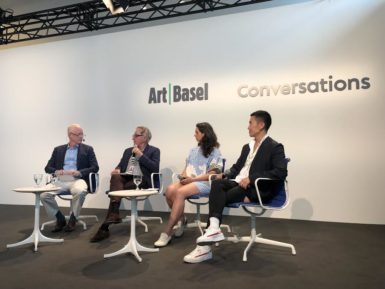[ad_1]

From left to right, Ed Winkelman, Howard Read, Irene Kopelman, and Kibum Kim.
ANNIE ARMSTRONG/ARTNEWS
In its new incarnation as a private dealership, New York’s Cheim & Read gallery will commission unspecified artists for a mural in Palm Beach in conjunction with that city’s Norton Museum of Art in February, as well as a sculpture at Chateau La Coste, collector Paddy McKillen’s private museum and winery in Provence, France.
This past summer, Cheim & Read, a 20-year-old gallery, announced that it would relocate from its large Chelsea space to the Upper East Side and become a private practice concentrating on the secondary market, sculpture commissions, and special projects. At the time, there were no specifics as to the commissions or projects. Longtime gallery partner Adam Sheffer left the business last December, and in July announced he would become Vice President of Pace Gallery. In May, the Joan Mitchell estate announced it would move to David Zwirner gallery.
Cheim & Read co-founder Howard Read made his announcement about the upcoming commissions this afternoon in Art Basel Miami Beach’s auditorium, in a panel discussion with art dealer and former gallery proprietor Ed Winkleman called “The Future of the Artist and Gallerist Relationship.” Also on the panel were lawyer/writer Kibum Kim and artist Irene Kopelman.
“We are in a crossroads right now,” Read said on the panel. “After three and a half decades in the traditional gallery/artist relation model, we’re transitioning into a new model in February.”
Read went on to both dignify that traditional model, which he referred to as the “Leo Castelli model,” after the legendary dealer who died in 1999, while also explaining that that model doesn’t entirely fit in the current art ecosystem, which is heavy on fairs and must contend with the internet.
“We’re now interested in a model that seems more progressive,” Read said. “This programming will be more flexible, and without the burden of infrastructure.”
Cheim & Read will continue to do art fairs—selectively.
“At first the art fair seemed like a more efficient model, where a collector or curator could see a year’s worth of gallery exhibitions over the course of a weekend,” Read said. “But, like print advertising, galleries felt the need to compete.”
Read says his gallery will continue to have a booth at Art Basel Miami Beach, where it has participated since the first edition in 2002. But he said the gallery will be more picky with which fairs they show at, and that TEFAF and “some of the newer fairs in Asia” are of interest.
“We’ve had instances of extraordinary commercial success in places like Miami and Abu Dhabi,” he said. “And yet in the same season, complete failure in Hong Kong and Paris.”
At a time of great flux in the art world, Read seemed optimistic. “We’re hoping that the future has less to do with these old school models we’re talking about, and more to do with the free agency status of artists,” he said.
[ad_2]
Source link

